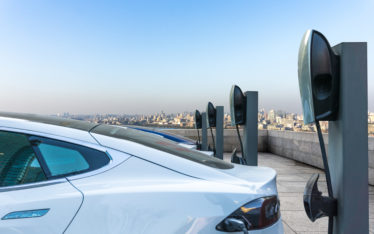Electric vehicles are poised to overtake gas-powered vehicles faster every year as their popularity grows, their efficiency and range increases, and more players enter the market. The push for electrification comes from all sides: from the highest levels of government and OEM management to first-time car buyers around the country and the world.
We touched on our industry’s moves toward sustainability in a previous blog post, as well as strategies you and your business can use to operate within them. Today we’re taking an in-depth look at the progress being made on E.V.s in terms of market and consumer sentiment shifts, growth in segment competition, and more.
Where Electric Vehicles Are and Where They’re Going
One of the most significant pieces of electric car news is Hertz’s purchase of 100,000 vehicles from Tesla. This deal, plus federal and state incentives and shifting consumer sentiment, means E.V.s are here to stay to put gasoline power out of a job.
An October 13th report from Cox Automotive notes that individual states are “in different stages of enacting limits on gasoline and diesel-powered vehicles.” Wall Street is also making moves, with companies in the energy sector investing in charging stations across the country to supplement the at-home charging most customers currently use.
The batteries powering E.V.s have a place in the spotlight as well. While there are currently greater up-front energy costs and emissions from producing them, a gas-powered car will produce much more over its lifespan than a battery-powered car: more than double, in fact. That data accounts for both the production and operation and operation over the vehicle’s average lifespan. If batteries continue to get more efficient and less environmentally costly to make, their carbon footprint shrinks by an additional 50%.
Electric vehicles also offer conveniences that further decrease their impact on the environment. Take the Ford F-150 Lightning, the OEM’s pure electric pickup. One of the most compelling new features is its ability to act as a generator for its owner’s home. Ford says that if the owner minimizes their home’s power consumption, the Lightning can power the house for a full three days on a full charge. Options like these are only one part of the equation pushing E.V.s forward. More OEMs are making pledges to phase out internal combustion engines (ICEs) in the coming years. The timeline for this shift varies from OEM to OEM, but most hope to reach reaching carbon-neutral or to produce only E.V.s by no later than 2050.
Honda, for instance, said it will only produce E.V.s and hybrid vehicles by as early as 2022. Bentley, Jaguar Land Rover, and Volvo are poised to focus purely electric by 2030. Mercedes is ahead of these three by five years, aiming to produce nothing but E.V.s by 2025. Many other big-name brands — GM, Hyundai-Kia, Nissan, Toyota, and others — haven’t yet committed to removing ICE vehicles from their lineup as yet. They have nevertheless made significant moves to increase their E.V. output and continue R&D in the sector.
The billions being spent are in search of a piece of a huge financial pie. A report by Meticulous Research via Global Newswire notes the electric car market is poised to reach $1.9 trillion in value and produce 69.3 million E.V.s by 2028. That’s a growth rate of 37.1% and 36.2%, respectively.
A separate report from Verified Market Research via P.R. Newswire shows there’s opportunity for the charging station sector to reach a market size of $34.32 billion, with a growth rate of 33.64%.
That exponential expansion is not without difficulties. The ongoing supply chain issues and chip shortage are enormous barriers to the advancement of E.V.s. There’s also a concerning scarcity in talent in both the white and blue-collar sectors, per a report from Delloite, with production workers and tech developers in high demand but lower than ideal supply. Solving these issues in the next few years would go a long way to pushing the segment even further forward.
Sentiment Across the Segment
Consumer sentiment around E.V.s continues to improve year-over-year. Forbes reports, per a poll of 33,000 U.S. drivers by YouGov, 22.9% of buyers would consider an electric vehicle as their next purchase. With the E.V. market sitting at a mere 3% of the total share compared to gas-operated vehicles, if even a fraction of those consumers purchased an electric car, we could see a 100% increase in clean vehicles on the road, maybe more.
Even more good news: sentiment around hybrid vehicles is strong, with the same YouGov survey seeing 27.1% of their respondents showing interest in hybrid power over pure gasoline. When combined, gas and diesel still hold a slight majority, with 57.3% of respondents choosing one or the other.
Regionally, electric is most popular on the west coast and in the northeast, at 25.6% and 26.8%, respectively. Their lowest point is in the South, where they rank at a significantly lower 19.8%. Hybrid is about 5% more popular across the board, though the South does not have the highest desire for gasoline. That goes to the Midwest at 48.3%.
E.V. adoption is thus more regionally biased, particularly along political and economic lines. Still, it’s heartening for the sector to imagine approximately 20% of people across the U.S. choosing an electric vehicle as their next means of transportation. It would mean a more than 500% increase in market share for electric vehicles, provided most of the respondents followed their reported choices.
Deloitte’s research supports such monumental expansion. In their 2021 Automotive Supplier Study, their report predicts a 475% increase in both electric drivetrains and batteries and fuel cells between 2020 and 2025. Advanced Driver-Assistance Systems (ADAS), like parking and collision warnings and assistance, could also increase by 150%, pushing efficiency and safety up even further.
It’s worth noting that the same Deloitte report doesn’t see the more traditional options going anywhere anytime soon. While ICEs will decline in market share somewhat, they will still be a $123 billion industry, down from $144 billion. That’s thanks in part to the solid hybrid market, which combines battery and gasoline power.
Employment issues, however, continue to temper growth. Manufacturers expect 2.1 million jobs to remain unfilled by 2030. Shortages remain for core materials, both for general protection — steel, for instance — and lithium, cobalt, and nickel needed for batteries. Unfilled roles at dealerships and issues at persistent issues in the supply chain compound matters further. Then there’s the availability of materials like microchips, which might not see improvement until 2023, especially with the newer chip form factors.
Despite these infrastructure problems, the U.S. should expect a wide range of E.V. options on dealer lots as soon as 2026. These options come from a variety of sources. A separate Deloitte Insights report, taking from IHS Markit, notes there will be a whopping 130 different electric models on offer from 43 total brands in a little under four years. The familiar names are all present, but there are also a surprising number of new players in the game looking to challenge and disrupt a quickly expanding market.
The Who’s Who of Electric Vehicles
Many of the industry’s biggest names are making considerable investments in E.V.s. Quite a few familiar names are present — Ford, Chevrolet, GMC, Honda, Kita, BMW, Volvo, etc. — but there are a significant number of new companies looking to capitalize on the growing popularity and revenue potential of electric. Motortrend details the 36 OEMs making moves in the E.V. market.
Almost all the newcomers have no interest in gas-powered vehicles: it’s electric or nothing. Like Tesla, these other ventures are putting their power toward creating a future where you’ll only see E.V.s on the road.
Companies like Lucid, Faraday Future, and Fisker are taking a luxury approach, putting them in direct competition with Tesla’s flagship Model S. In fact, that $100,000 price point seems to be the target of most start-ups on MotorTrend’s list. Prices might dip as low as $75,000 and reach up to around $125,000, but Tesla’s Model S and X remain the ideal targets.
Two carmakers, Byton and Canoo, have placed their focus squarely on feature-rich affordability. Byton’s sedan and SUV offerings price between $40,000 and $70,000, depending on options. The familiar form factor of both of Byton’s vehicles could give them an upper hand on Canoo, who have foregone a more traditional look for their vision of futuristic. A Canoo vehicle’s aesthetic is certainly out of the ordinary, but their price is anything but offputting: their flagship starts at around $34,000. Most major OEMs continue to target an affordable price point. The Chevrolet Bolt retails for $40,000, the Nissan Leaf goes for around $30,000, and Ford’s Mustang Mach-E only asks about $50,000.
On the other side of this equation are the highest high-end vehicles built for customers for whom money is no object. Lamborghini threw their hat in the ring with the Terzo Millennio concept in collaboration with MIT, showing that E.V.s can reach even the most discerning car buyers. Two other companies, Aspark fo Japan and Pininfarina of Italy, have electric super and hypercars in the pipeline with pricetags easily exceeding $2 million per unit.
***
Put simply, every corner of the market will soon boast some kind of electric vehicle. A customer’s financial situation will matter significantly less, and modern features will be easier to come by, even at lower price ranges. New and established names are making big plays in all form factors, with some vehicles offering features impossible without an electrically-powered engine.
Our industry went through perhaps its biggest test between 2020 and 2021. Even with all the challenges we faced, we have come out stronger in more ways than we have built weaknesses. We work leaner, more efficiently, and are ready to pivot more often and faster than ever before.
At ReVo MG, we have faith that there are huge positives for our industry going forward. Whatever difficulties we might face, everyone involved has the ability and intent to overcome them. That’s why we’ve developed solutions for the current market, whether your dealership needs to focus on pre-owned vehicles or new, electric or gas-powered. Contact us today to learn more.




